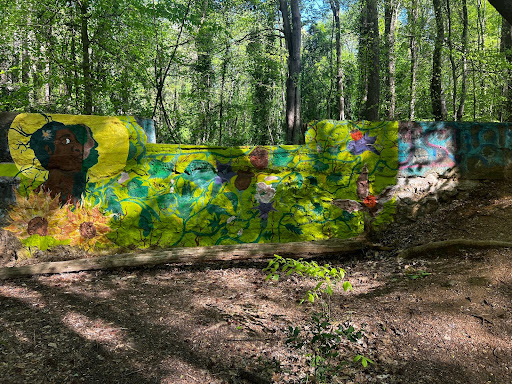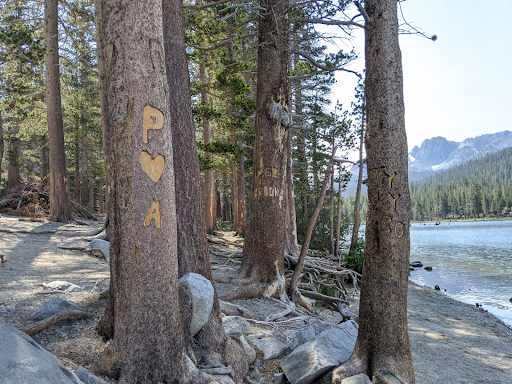Nestled in the back of the Guilford College woods is a lone champion tulip poplar tree. At more than 350 years old, it has borne witness to the valiant escape of freedom seekers along the Underground Railroad. If you walk a little further, you will come across a vibrant mural depicting a history of heartache and triumph made immortal by the stroke of a brush.
Painted in strokes of vibrant greens, yellows and browns, the mural features a Black man haloed by the sun. Surrounding him are leafy vines, sunflowers, and even a few acorns. Sitting on the face of a rock, the artwork has a unique collection of bends and breaks across the surface that mirror the arduous journey freedom seekers made as they traveled North.
Guilford College’s archivist Gwen Erickson specializes in Quaker history. She said the college has always had ties to the Underground Railroad.
“The land the college is on has always been a crossroads for freedom seekers,” said Erickson. She said freedom seekers would seek refuge in the Guilford woods because there were sympathetic Quakers and members of the free Black community nearby.
The mural is part of a larger project on ethnobotany led by Tony VanWinkle in the Environmental Studies Department. Ethnobotany is the study of human cultural relationships with plants. Four years in the making, VanWinkle said he and a small group of people applied for a grant from the National Parks Service to fund the exhibit, including new signage and the mural.
The mural was designed by current student Breyanna Moore and executed by Guilford alumni Terri Jones and Alyzza May. VanWinkle said they went through several iterations before settling on the final design.
VanWinkle shared the following quote by French Philosopher Dénètem Touam Bona
with Moore, inspiring her design:
The cimarrón is a runaway slave, tearing off a servile skin to take on the striated shadow of foliage in his or her mad sprint. His or her liberation comes about from the process of going wild, from an act of immersion in the forest, the sylve (from the Latin noun sylva ‘forest,’ which is at the root of the word savage) — an act that makes him into a forest creature, a ‘leaf-being.’
Moore said the quote exhibited the perfect relationship between man and nature, emphasizing the project’s roots in ethnobotany.
To select the plants included in the mural, Moore relied on what she learned in one of VanWinkle’s courses, in which he taught the history of plants, their origins, and benefits. She said she chose the ones that were most likely to have been present in the Guilford Forest so that it would give the mural an even more personal link to the history of the area’s plants and importance along the Underground Railroad.
For Moore, the most important aspect of the mural was the figure in the middle slowly blending in with the foliage.
“To me, that was a focal point that I really wanted to convey right and in a way that could possibly create many different meanings for the viewers,” said Moore. “It was important for me to add my spin to the design outside of the quote and other historical references.”
Nature’s role in human life was an integral part of this project. Moore’s hope for this mural is that it will continue to inspire curiosity and gratitude for the wildlife that sustains us.
“Nature is more than just a decoration,” said Moore. “Nature is something that should be treasured with respect and love and should be valued like it once was. Hopefully, after viewing the mural, viewers are encouraged to learn more about the plants, cultural traditions, and historical significance of Greensboro and Guilford College.”







